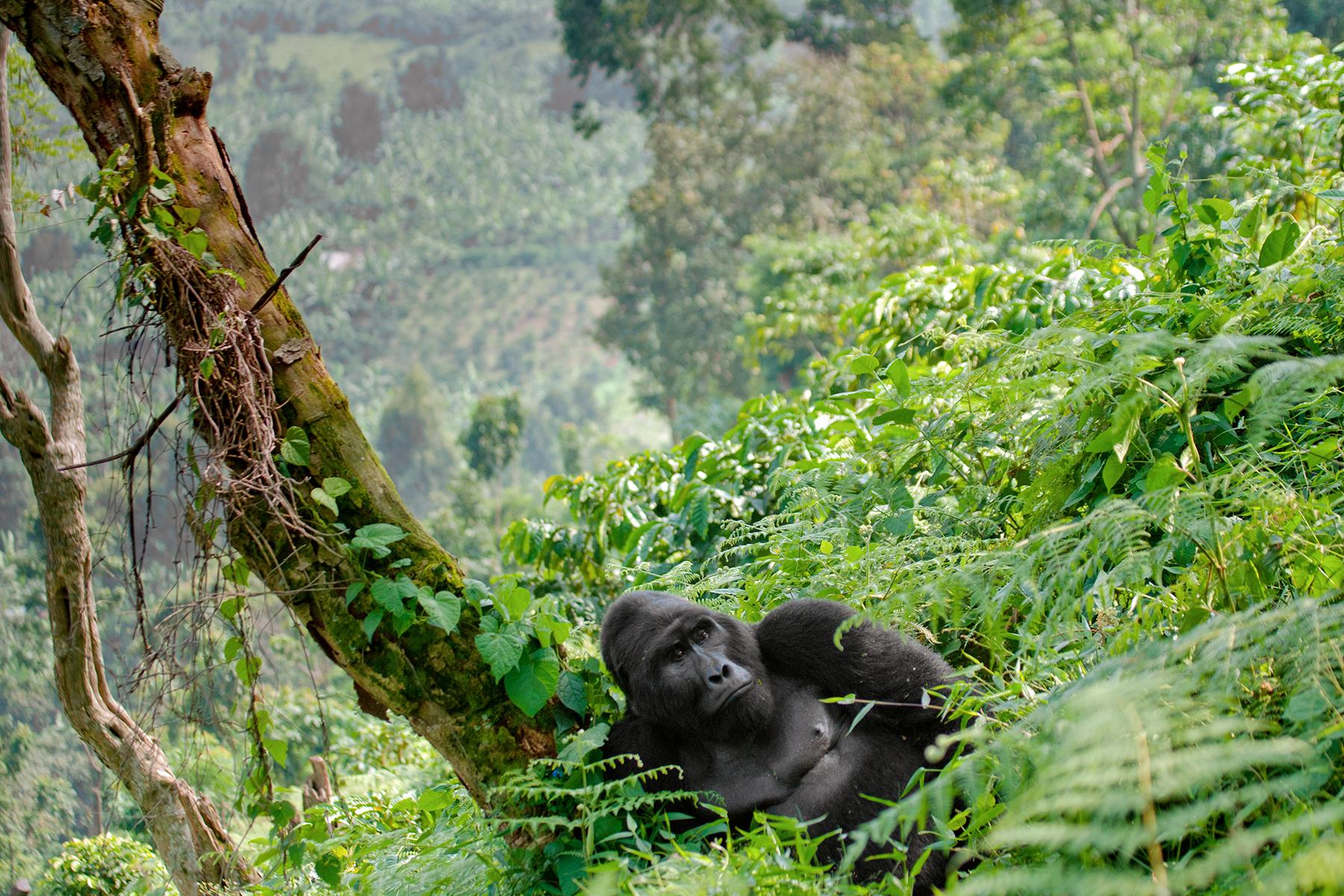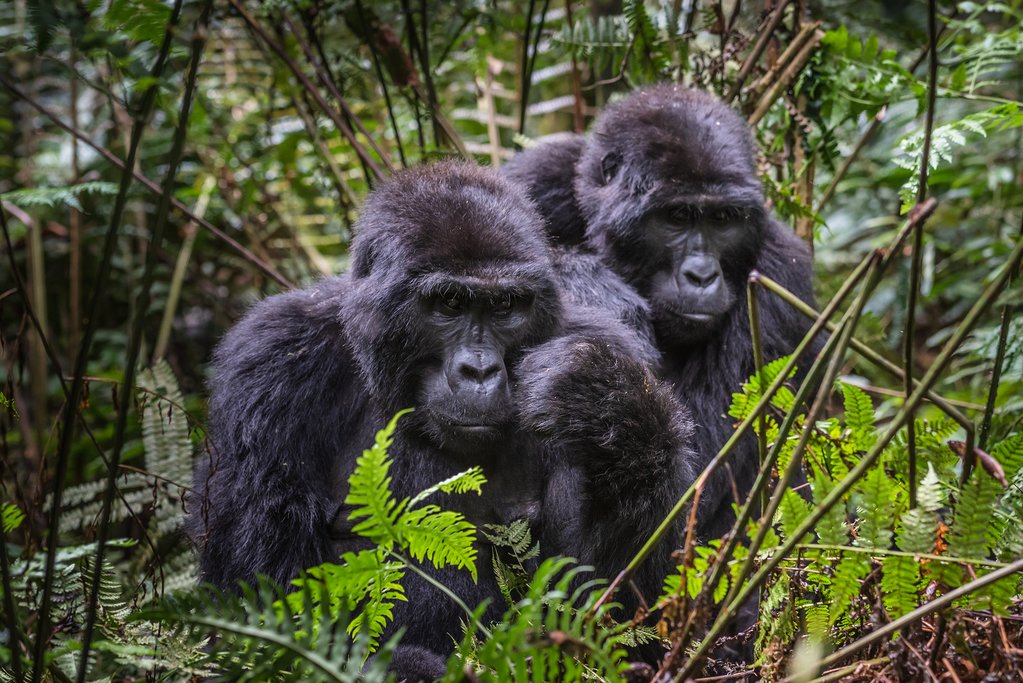Gorilla Trekking: Uganda vs. Rwanda
Mountain Gorilla Trekking is one of Africa’s premier wildlife experiences, imagine hiking through lush misty forests, hearing branches crack, stepping past vines and eventually coming face to face with a Gorilla family in the wild. Two of the best places in the world to do this are Uganda (Bwindi Impenetrable Forest, Mgahinga Gorilla Park) and Rwanda (Volcanoes National Park). Both offer unforgettable experiences, but they differ in cost, terrain, ease, comfort, and style. Which you choose will depend on what matters most to you: adventure, comfort, budget, or time
Gorilla Permits & price
One of the first and biggest decisions you will make is where to buy your Gorilla permit and that choice has real financial consequences. Rwanda charges a premium: the standard Gorilla permit for international visitors is USD1,500 per person (with discounted rates for Rwandan/East African residents).
Uganda’s permit has traditionally been lower (commonly quoted around USD800 per person for international visitors, depending on the official channel and residency status) when trekking in Bwindi or Mgahinga National Parks. Uganda also offers Gorilla habituation permits at USD1500 a longer, more immersive (and costlier) experience allowing more time with a family. These price differences are a major reason some travelers choose Uganda even if they only have time for one country.
Accessibility & Logistics
Uganda
Bwindi Impenetrable Forest National Park is quite a distance from major Entebbe International Airport. By road it can take 8‑10 hours. There are domestic flights to airstrips closer to the forest (e.g. Kihihi or Kisoro) which shorten the travel time, but add cost.
Because Uganda has several sectors (Buhoma, Ruhija, Rushaga, Nkuringo, etc.), you have more options in planning both for difficulty and for matching your accommodation.
Mgahinga Gorilla National Park is accessible by road or air, with the nearest town being Kisoro. Road access involves a long drive from Kampala through Kabale. By road it’s about 8 hours. The flight takes approximately 1 hour and 10 minutes.
Rwanda
Rwanda’s Volcanoes National Park is compact and efficient. Kigali, the capital, is a comfortable gateway with a roughly 2–3 hour drive to the park depending on road and traffic — which means many visitors fly into Kigali and reach their lodge the same day. Rwanda’s tourism infrastructure
is tightly focused on Volcanoes NP and gorilla tourism, so transfers, short itineraries, and multi- day stays are straightforward.
Trekking Experience & Terrain
Both Countries offer humid, steep, muddy forest hikes that can last anywhere from 30 minutes to a full day. The Gorillas decide where to be that day. But the trekking “feel” differs.
Uganda
Bwindi Impenetrable Forest National Park & Mgahinga Gorilla National Park is steep, dense, with thick undergrowth, muddy trails, uneven ground. For many trekkers it is more physically demanding.
Trekking times vary widely. Depending on where the Gorilla group has slept or moved, it might take 2‑6 hours or even more to find them. Uganda’s forests are more “wild” feeling: more remote, more jungle‑density, and more variety of sectors.
Rwanda
Volcanoes National Park has somewhat gentler trails overall. The vegetation is often less dense (in certain parts), terrain is more volcanic slope, bamboo forest, etc.
Treks tend to be shorter on average (for many Gorilla families) since the park is smaller and infrastructure more concentrated. Some walks might be just a few hours (1‑4 hours) depending on the gorilla group.
Visibility can be better in Rwanda because of more open forest in places; fewer thick undergrowth compared to some sectors in Bwindi. Easier to take photos.

mountain gorillas in Uganda
Number of Gorilla Families & Chances of Encountering Them
Uganda
Uganda has more than 20 habituated Gorilla families, primarily in Bwindi Impenetrable Forest National Park (with four trekking sectors: Buhoma, Ruhija, Rushaga, and Nkuringo) and one in Mgahinga Gorilla National Park. The higher number of families means more permits available daily (about 160+), increasing accessibility.
Gorilla tracking success in Uganda is very high (95–99%) because rangers and trackers locate Gorilla groups early in the day and guide tourists accordingly. Trek duration can vary widely (2– 8+ hours), depending on Gorilla movement and forest density.
Rwanda
Rwanda has around 12 habituated gorilla families in Volcanoes National Park. The number of permits is more limited (around 96 daily), making the experience less crowded and more exclusive.
The terrain is more open in some areas (e.g., bamboo forest), and the park is smaller and more accessible, so treks tend to be shorter and sightings more predictable.
The success rate of seeing gorillas is also extremely high (near 100%).
Conservation & community impact
Both countries tie Gorilla tourism to conservation revenue and community benefits, but they approach it slightly differently. Rwanda places tourism at the center of a national conservation and branding strategy: high fees fund protection and community projects, and the Volcanoes National Park model is highly centralized and performance-driven.
Uganda has a longer history of community-based approaches around Bwindi, with multiple sectors, community-development projects, and a broader spread of tour operators and lodge styles. For those interested in community visits, Batwa cultural experiences, or seeing a wider range of landscapes, Uganda often offers more options. Independent assessments suggest both countries have contributed substantially to mountain gorilla recovery, though each faces ongoing challenges like human-wildlife conflict and habitat pressure.
 Which One Should You Choose?
Which One Should You Choose?
Gorilla Trekking in Uganda vs Rwanda – Based on Your Priorities Budget-Friendly
Uganda might be better if you want lower permit cost, more options for lodging, don’t mind more travel or tougher hiking. WHILE Rwanda might be better if you don’t mind paying more for convenience, comfort, and shorter travel times.
Adventure / Challenge
Uganda might be better if you enjoy rugged forest, longer treks, more variable terrain, “into the wild” feel. WHILE Rwanda might be better if you prefer ease, predictability, somewhat gentler hikes, less extreme terrain.
Time available
Uganda might be better if you have more days to spare, okay with longer transfers, and want to combine with other wildlife or locations. WHILE Rwanda might be better if you have limited time, perhaps arriving via Kigali or want to minimize travel, want fewer moving parts.
Cultural / Multi‑experience Travel
Uganda might be better if you want to combine gorilla trekking with other wildlife, lakes, birding, and cultural visits. WHILE Rwanda might be better if you are happy to focus heavily on gorillas, with cultural or scenic side‑trips, but less varied wildlife options.
Best Times & Seasons
When is best to trek, and how seasons affect experience.
Both Countries have dry and wet seasons. Dry seasons (typically June‑August and December‑February) are more comfortable: less mud, better trail conditions, fewer slippery slopes, better visibility.
Wet seasons may have drawbacks (mud, more strenuous hiking, slippery, more rain) but also advantages: fewer tourists, often lower accommodation cost, sometimes more vibrant forest, more likelihood of seeing certain birds or plants in flower.
Drawbacks & Things to Watch Out For
Some caveats, trade‑offs, issues you might want to keep in mind.
Weather can make trails slippery, muddy, and even impassable at times. Rain is frequent in both countries; in Uganda especially, forest floor conditions can degrade hiking comfort.
Altitude can affect people differently; trekking classes may go up high. If you’re sensitive to altitude or have health issues, plan accordingly.
Permit availability: despite the high cost in Rwanda, demand is very high; you’ll need to book well in advance. Same in Uganda during peak seasons.
Travel time and internal transport: Uganda’s more remote parks mean more travel time. Poor road infrastructure in some stretches might add delays.
Ethical conservation: ensure you use tour operators and lodges that are responsible, contribute to conservation, and respect gorilla welfare rules (distance, time limit with gorillas, etc.).

Mountain Gorillas in Bwindi
Conclusion
Gorilla Trekking in both Uganda and Rwanda offers a once-in-a-lifetime chance to connect with mountain gorillas in their natural habitat. While Rwanda delivers a premium, streamlined, and luxury-focused experience at a higher price, Uganda provides a more adventurous, diverse, and cost-friendly alternative with wider itinerary options. Ultimately, the choice depends on whether you prioritize efficiency and comfort or adventure and variety. Whichever destination you choose, the encounter with these gentle giants will leave you with unforgettable memories and a deeper appreciation for conservation.